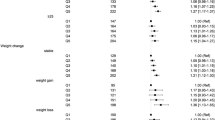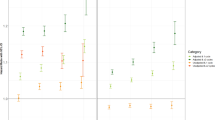Abstract
Background
There is some evidence to suggest that there may be a link between body mass index (BMI) and the development of kidney stones, it remains unclear whether weight change was associated with the presence of kidney stone.
Aims
The objective of this study was to investigate the potential association between changes patterns in weight during adulthood and the incidence of kidney stone.
Methods
This study included 14472 participants aged 30-75 years, whose BMI was recorded at both baseline and 10 years prior to the survey. We categorized individuals into five weight change patterns: stable healthy, non-obesity to obesity, obesity to non-obesity, stable obesity, and maximum overweight. Odds ratios (OR) and 95% confidence intervals (CI) relating weight change to incident kidney stone were calculated using logistic regression models adjusting for covariates. The non-linear association between absolute weight change was investigated using the restricted cubic spline (RCS) regression. The supposed population attributable fraction (PAF) for the weight change patterns was calculated.
Results
After adjusting for all confounders, participants changing from non-obesity to obesity, obesity to non-obesity, and stable obesity had significantly higher risks of kidney stone than those with healthy weight during adulthood (OR = 1.59, 95% CI:1.18–2.13; OR = 1.78, 95% CI: 1.47–2.16; OR = 1.80, 95% CI: 1.48–2.19, respectively). A U-shaped association was observed, and the risk of kidney stone was lowest in participants with stable healthy BMI. If the population had maintained a healthy BMI, a 28.7% (95% CI: 18.6%–37.5%) lower incidence of kidney stones was observed.
Conclusions
This study found that changes in weight during adulthood are linked to the risk of developing kidney stones. Maintaining healthy weight during adulthood is important for reducing the risk of developing kidney stones.
This is a preview of subscription content, access via your institution
Access options
Subscribe to this journal
Receive 12 print issues and online access
$259.00 per year
only $21.58 per issue
Buy this article
- Purchase on Springer Link
- Instant access to full article PDF
Prices may be subject to local taxes which are calculated during checkout


Similar content being viewed by others
Data availability
Publicly available dataset was analyzed in this study. The National Health and Nutrition Examination Survey dataset are publicly available at https://www.cdc.gov/nchs/nhanes/index.htm.
References
Ferraro PM, Bargagli M, Trinchieri A, Gambaro G. Risk of kidney stones: influence of dietary factors, dietary patterns, and vegetarian-vegan diets. Nutrients. 2020;12:779.
Zisman AL, Coe FL, Cohen AJ, Riedinger CB, Worcester EM. Racial differences in risk factors for kidney stone formation. Clin J Am Soc Nephrol. 2020;15:1166–73.
Scales CD Jr., Smith AC, Hanley JM, Saigal CS. Prevalence of kidney stones in the United States. Eur Urol. 2012;62:160–5.
Trinchieri A, Ostini F, Nespoli R, Rovera F, Montanari E, Zanetti G. A prospective study of recurrence rate and risk factors for recurrence after a first renal stone. J Urol. 1999;162:27–30.
Taylor EN, Stampfer MJ, Curhan GC. Obesity, weight gain, and the risk of kidney stones. Jama. 2005;293:455–62.
Ferraro PM, Taylor EN, Gambaro G, Curhan GC. Soda and other beverages and the risk of kidney stones. Clin J Am Soc Nephrol. 2013;8:1389–95.
Bhupathiraju SN, Hu FB. Epidemiology of obesity and diabetes and their cardiovascular complications. Circ Res. 2016;118:1723–35.
Stokes A, Collins JM, Grant BF, Scamuffa RF, Hsiao CW, Johnston SS, et al. Obesity progression between young adulthood and midlife and incident diabetes: a retrospective cohort study of U.S. adults. Diabetes Care. 2018;41:1025–31.
Chen C, Ye Y, Zhang Y, Pan XF, Pan A. Weight change across adulthood in relation to all cause and cause specific mortality: prospective cohort study. Bmj. 2019;367:l5584.
Liu M, Zhang Z, Zhou C, He P, Zhang Y, Li H, et al. Relationship of weight change patterns from young to middle adulthood with incident cardiovascular diseases. J Clin Endocrinol Metab. 2021;106:e812–e823.
Zheng Y, Manson JE, Yuan C, Liang MH, Grodstein F, Stampfer MJ, et al. Associations of weight gain from early to middle adulthood with major health outcomes later in life. Jama. 2017;318:255–69.
Rockhill B, Newman B, Weinberg C. Use and misuse of population attributable fractions. Am J Public Health. 1998;88:15–9.
Siener R, Glatz S, Nicolay C, Hesse A. The role of overweight and obesity in calcium oxalate stone formation. Obes Res. 2004;12:106–13.
Poore W, Boyd CJ, Singh NP, Wood K, Gower B, Assimos DG. Obesity and its impact on kidney stone formation. Rev Urol. 2020;22:17–23.
Sakhaee K, Maalouf NM, Sinnott B. Clinical review. Kidney stones 2012: pathogenesis, diagnosis, and management. J Clin Endocrinol Metab. 2012;97:1847–60.
Chen M, Tsai CW, Chang WS, Xiong GY, Xu Y, Bau DT, et al. High circulating insulin-like growth factor-1 reduces the risk of renal cell carcinoma: a Mendelian randomization study. Carcinogenesis. 2021;42:826–30.
Ekeruo WO, Tan YH, Young MD, Dahm P, Maloney ME, Mathias BJ, et al. Metabolic risk factors and the impact of medical therapy on the management of nephrolithiasis in obese patients. J Urol. 2004;172:159–63.
Trinchieri A, Croppi E, Montanari E. Obesity and urolithiasis: evidence of regional influences. Urolithiasis. 2017;45:271–8.
Apovian CM. Obesity: definition, comorbidities, causes, and burden. Am J Manag Care. 2016;22:s176–85.
Boyd C, Wood K, Whitaker D, Assimos DG. The influence of metabolic syndrome and its components on the development of nephrolithiasis. Asian J Urol. 2018;5:215–22.
Acknowledgements
The authors thank the National Center for Health Statistics of the Centers for Disease Control and Prevention for sharing the National Health and Nutrition Examination Survey (NHANES) data.
Author information
Authors and Affiliations
Contributions
EZ, YG, and RX participated in literature search, study design, data collection, data analysis, data interpretation, and wrote the manuscript. EZ, YG, and RX, and CZ conceived of the study, and participated in its design, coordination, data collection and analysis. EZ, and CZ participated in study design and provided the critical revision. All authors read and approved the final manuscript.
Corresponding author
Ethics declarations
Competing interests
The authors declare no competing interests.
Ethics approval
The conduct of NHANES was approved by the National Center for Health Statistics (NCHS) Research Ethics Review Board and written informed consent was given by all participants at the time of recruitment.
Additional information
Publisher’s note Springer Nature remains neutral with regard to jurisdictional claims in published maps and institutional affiliations.
Rights and permissions
Springer Nature or its licensor (e.g. a society or other partner) holds exclusive rights to this article under a publishing agreement with the author(s) or other rightsholder(s); author self-archiving of the accepted manuscript version of this article is solely governed by the terms of such publishing agreement and applicable law.
About this article
Cite this article
Zhao, E., Gao, Y., Xiao, R. et al. Patterns of weight change during adulthood and incidence of nephrolithiasis: a population-based study. Int J Obes 48, 461–468 (2024). https://doi.org/10.1038/s41366-023-01434-x
Received:
Revised:
Accepted:
Published:
Issue Date:
DOI: https://doi.org/10.1038/s41366-023-01434-x



